

Away from toys, people, windows, TVs, radios, and anything else your child likes.Your child does not follow your direction and you have given a warning.Your child does something harmful, like hurting others.There are 4 times when time-out may be a good choice: For toddlers and preschoolers, try distraction and redirection first. Time-out is not used for all misbehaviors. She cannot interact with her parents or anyone else. She does not get any attention in time-out. Your child is away from all things that are fun. Time-out is when your child is removed from where the misbehavior happened. What is Time-Out? When should it be used? Time-outs last between 2 and 5 minutes for toddlers and preschoolers.The location should be away from TV, games, toys, or other things your child likes. Select a time-out location where your child cannot get attention from anyone.Follow the 5 steps for time-out each time you use it.Use other types of consequences for other problem behaviors. Use time-out if your child does something dangerous or harmful, fails to follow a direction, or breaks a family rule. Limit time-outs with toddlers and preschoolers.Practice time-out with your child so she knows how it will work. Tell your child which behaviors will lead to time-out, where time-outs will happen, and how time-out will be used. Explain time-out to your child before using it.The Time-Out Chair and Other Alternatives.What is Time-Out? When should it be used?.


 0 kommentar(er)
0 kommentar(er)
